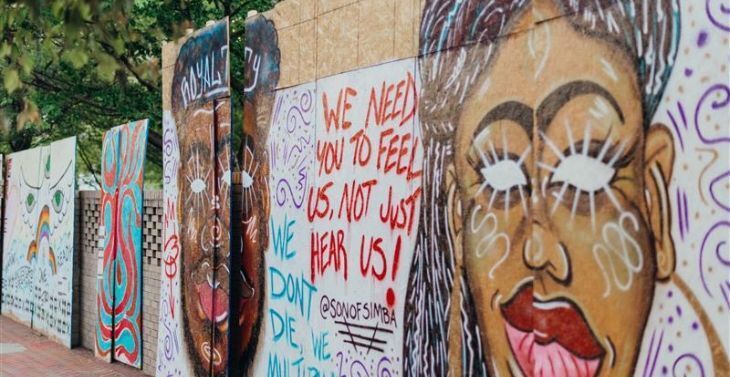Photo by Carly Mackler on Unsplash
The arts are not a frill. The arts are a response to our individuality and our nature, and help to shape our identity. What is there that can transcend deep difference and stubborn divisions? The arts. They have a wonderful universality. Art has the potential to unify. It can speak in many languages without a translator. The arts do not discriminate. The arts can lift us up.
~ Former U.S. Texas Congresswoman Barbara Jordan
Art as Witness
Art marks the comings and goings of ages past and imagines those to come. Humankind has expressed itself in the arts--from the prehistoric cave paintings at Lascaux, the eighteenth century BCE poem Epic of Gilgamesh, and the many forms of pottery and jewelry found in the remains of ancient cultures throughout the world, to the myriad of art forms in the 21st century that encompass motion pictures, digital photography, computer art, and experimental novels. Art is an enduring cultural phenomenon.
Art can, with words or wordlessly, through sound or in silence, shout a message, break a heart, invoke a laugh, evoke a tear, motivate, agitate, and elevate. And art can simply exist—a witness to joy and suffering, to hardship and hope, to what it is to be human in a given time and place.
Compassion and the arts share a deep connection. The arts can evoke and promote compassion by providing a platform for emotional expression, fostering empathy, encouraging social activism, facilitating healing, creating spaces for dialogue, and inspiring social change. Through the arts, individuals can engage with and explore the complexities of the human experience, fostering a deeper understanding, empathy, and compassion for others.
Mission
Utilize the arts, all arts, as a vehicle to express the heart of compassion.
Vision
Envision a world where we can harness the transformative power of creativity to foster compassion, social impact, and positive change within communities and beyond.
Goals
- Promote Compassion: The primary goal of a compassionate arts project is to foster compassion and empathy among participants, artists, and audiences. This can be achieved by creating art that elicits emotional responses, challenges biases, and encourages understanding and connection with diverse perspectives and experiences.
- Encourage Social Justice and Advocacy: Compassionate arts projects often aim to address social injustices, raise awareness about marginalized communities, and advocate for positive social change. The project can focus on highlighting and challenging systemic issues, promoting equality and inclusion, and amplifying the voices of those who are underrepresented or marginalized.
- Encourage Community Engagement and Empowerment: Compassionate arts projects seek to engage and empower communities, providing opportunities for individuals to express themselves, collaborate, and actively participate in the artistic process. The project can involve community-based workshops, participatory performances, and collaborations with local organizations, fostering a sense of ownership and empowerment.
- Promote Healing and Well-Being: Another goal of compassionate arts projects is to promote healing and well-being among individuals affected by trauma, discrimination, or other hardships. Through artistic expression, participants can find a means of catharsis, self-expression, and personal growth. The project may include art therapy programs, trauma-informed practices, and spaces for emotional support.
Strategies
In order to realize the above goals, the Charter for Compassion Arts Sector, will promote and utilize the strategies listed here:
- Collaborative Approach: Compassionate arts projects often employ a collaborative approach, involving artists, community members, and stakeholders in the planning, implementation, and evaluation processes. Collaboration fosters shared ownership, diverse perspectives, and a collective commitment to compassion and social impact.
- Inclusivity and Accessibility: The project should strive to be inclusive and accessible, ensuring that individuals from diverse backgrounds, abilities, and socio-economic statuses can participate and engage. This may involve offering free or affordable workshops, providing accommodations for different needs, and creating safe and welcoming spaces.
- Community Partnerships: Building partnerships with community organizations, schools, cultural institutions, and local stakeholders is crucial for the success of a compassionate arts project. Collaborating with organizations that already work in the community can provide access to resources, expertise, and a broader network for sustainable impact.
- Education and Skill Development: Compassionate arts projects often incorporate educational components, providing opportunities for artistic skill development, learning about social issues, and fostering critical thinking. Workshops, mentorship programs, and educational resources can empower participants to use their artistic abilities for positive social change.
- Storytelling and Narrative Building: Utilizing storytelling and narrative-building techniques can be powerful strategies in a compassionate arts project. Through personal stories, participants can share their experiences, challenge stereotypes, and promote understanding. This may involve workshops on storytelling, oral history projects, or digital storytelling initiatives.
- Evaluation and Reflection: Regular evaluation and reflection are essential for a compassionate arts project to assess its impact, effectiveness, and alignment with goals. Collecting feedback from participants and audiences, reflecting on successes and challenges, and adapting strategies based on lessons learned can help enhance the project's outcomes and ensure ongoing compassion and growth.









